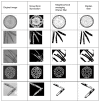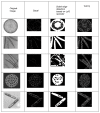Automatic identification of algal community from microscopic images
- PMID: 24151424
- PMCID: PMC3798295
- DOI: 10.4137/BBI.S12844
Automatic identification of algal community from microscopic images
Abstract
A good understanding of the population dynamics of algal communities is crucial in several ecological and pollution studies of freshwater and oceanic systems. This paper reviews the subsequent introduction to the automatic identification of the algal communities using image processing techniques from microscope images. The diverse techniques of image preprocessing, segmentation, feature extraction and recognition are considered one by one and their parameters are summarized. Automatic identification and classification of algal community are very difficult due to various factors such as change in size and shape with climatic changes, various growth periods, and the presence of other microbes. Therefore, the significance, uniqueness, and various approaches are discussed and the analyses in image processing methods are evaluated. Algal identification and associated problems in water organisms have been projected as challenges in image processing application. Various image processing approaches based on textures, shapes, and an object boundary, as well as some segmentation methods like, edge detection and color segmentations, are highlighted. Finally, artificial neural networks and some machine learning algorithms were used to classify and identifying the algae. Further, some of the benefits and drawbacks of schemes are examined.
Keywords: Algae identification; feature extraction; identification; neural network; segmentation.
Figures



References
-
- Mansoor H, Sorayya M, Aishah S, Moshleh MAA. Automatic recognition system for some cyanobacteria using image processing techniques and ANN approach. 2011 International Conference on Environmental and Computer Science. 2011;19:73–8.
-
- Anton A. Malayan Nature Society. Intern Development and Research Centre of Canada; 1991. Algae in the conservation and management of freshwaters.
-
- Culverhouse PF, Williams R, Benfield M, et al. Automatic image analysis of plankton: future perspectives. Mar Ecol Progr Ser. 2006;312:297–309.
-
- Weeks PJD, Gauld ID, Gaston KJ, O’Neill MA. Automating the identification of insects: a new solution to an old problem. Bull Entomol Res. 1997;87(2):203–11.
-
- Culverhouse PF, Williams R, Reguera B, Herry V, González-Gil S. Do experts make mistakes? A comparison of human and machine identification of dinoflagellates. Mar Ecol Progr Ser. 2003;247:17–25.
LinkOut - more resources
Full Text Sources
Other Literature Sources

